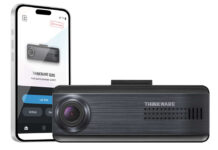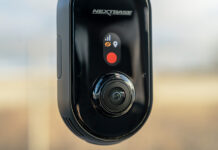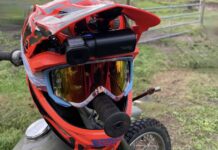
The Thinkware F70 Dashcam is a full HD 1080p camera that packs in many useful features. This dashcam is doubly-impressive as it is both easy to install and just as easy to use—delivering crisp, clear audio and video. Here is a closer look at my experience with this sleek and functional dashcam unit.
Simple enough for anyone to install
Getting up and running with the Thinkware F70 Dashcam could scarcely be much easier. The camera itself simply clicks in place on to the mount. From here it is only a matter of affixing the mount to your windshield via the built-in adhesive strip.
You’ll want to ensure when mounting the dashcam not to obstruct the driver’s view in any way. Thanks to the compact design of the Thinkware F70 Dashcam it fits perfectly right behind the rear-view mirror. For the best shooting angle you’ll also want to ensure that the lens is centered in the middle of your windshield. This means mounting the body of the camera slightly to the left, as the lens skews to the right side of the unit. Upon mounting the camera you may wish to take a few sample videos to test the horizontal angle. After making any necessary adjustments, tightening the mount will ensure the angle remains set.
The dashcam receives its power from a standard 12V auxiliary “cigarette-lighter” style adapter. The cable is lengthy and can be mostly hidden by tucking it into the space between the windshield and the vehicle’s interior moulding. Adhesive clips also assist to hold the wire in place at strategic points.

Hardwiring option
If you would prefer to hardwire the Thinkware F70 Dashcam directly to your vehicle, this option is available. This will require the additional purchase of the optional Thinkware Hardwiring Cable however. You’ll also need the proper tools and hardware for wiring. It’s important to note that the manufacturer recommends that a professional mechanic performs the hardwired installation. As with any such project, there is always the risk of damage to the product or vehicle if done incorrectly. Only those who are confident in their ability to take this task should do so without professional assistance.
That said, there are resources available through Best Buy to assist in your efforts. Take a look at this video for more information on the hardwired installation option. The biggest upside to hardwiring the Thinkware F70 Dashcam is that it allows for recording when your vehicle is not running. This enables the “Parking Surveillance Mode” feature. In this mode, the Thinkware F70 Dashcam will initiate a recording if it senses an impact even when the engine is off.

Multiple ways to record
Once installation is complete, you’ll be ready to start recording! The Thinkware F70 Dashcam documents your travels and potential incidents with multiple recording features. In particular, they make it easy to find the videos that are likely most relevant. Firstly, recording begins as soon as you start your vehicle. The dashcam then produces videos in one minute increments for the duration of your travels. The files are named and saved on the memory card denoting the date and time of each segment.
You can also initiate a manual recording with the Thinkware F70 Dashcam. This is accomplished by pressing the “record” button located on the left side of the unit. The dashcam will confirm verbally that it is creating a manual recording. These videos will be saved to a separate, segregated folder on the memory card, making them easy to find later on.
A manual recording will actually begin 10 seconds prior to pressing the record button. It will subsequently then run for an additional 50 seconds. This is handy as in most cases, the event that leads drivers to want to make a manual recording in the first place often occurs prior to the decision to press record.

A separate location for incident recordings
Any time the Thinkware F70 Dashcam detects any sort of jolt or impact to your vehicle, it automatically separates that particular segment of video to a unique folder on the memory card. This design makes it easy to find the videos that you are likely to be searching for later on.
It would be very time-consuming to have to search through the cumbersome tranche of ongoing videos or having to remember the exact time an incident occured. Luckily, owners can instead quickly browse to all videos earmarked as involving a potential accident or impact. This is a handy feature to be sure. However it does have one potential downside. The metric that registers what is or is not a relevant impact is very sensitive. In my travels I found that any pothole, bump, or even rough stretch of road was enough to register an “incident”.
This in itself isn’t so bad—I certainly would rather that this feature be overly-inclusive rather than the opposite. However, the dashcam also makes a fairly audible and chirpy beep to indicate the detection of an impact. On one hand it’s nice to know the dashcam is working in the event of a real accident. On the other hand, the chirping noise may become irritating when travelling on a bumpy stretch of pavement.

The Thinkware F70 Dashcam records quality HD video with simple operation and easy installation
Overall the quality full HD 1080p video that the Thinkware F70 Dashcam delivers is excellent. Both the picture and audio are crystal clear, making every essential detail easy to distinguish. This is tantamount when so much importance can be placed on what your dashcam sees when critical events occur while driving. The installation is simple enough that just about anyone should be able to set up the Thinkware F70 Dashcam without issue. And of course an optional hardwired installation is available for those with sufficient skill—or the assistance of a professional mechanic. Keep in mind however that the hardwiring cable is a separate purchase.
Finally, with easy operation and an intuitive file system for segregating manual recordings and impact detection, the Thinkware F70 Dashcam makes for a user-friendly solution for anyone looking for additional security and peace of mind on the road.



